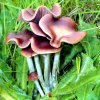When it comes to psychedelic mushrooms, few species are as renowned and widely debated as Psilocybe cubensis and Psilocybe cyanescens. Though both are members of the psilocybin-containing fungi family, they boast unique characteristics that set them apart in terms of appearance, potency, habitat, and historical significance. Let’s take a deep dive into what makes these two species so fascinating.
Growing Conditions and Climate Preferences
- Psilocybe cubensis:
- Optimal Environment: Psilocybe cubensis thrives in warm, tropical, and subtropical climates. Commonly found in cow pastures, this mushroom often grows on bovine or equine dung, thanks to its nutrient richness.
- Temperature Range: Ideal colonization occurs between 75–85°F (24–29°C), with high humidity crucial for fruiting.
- Ease of Cultivation: P. cubensis is considered the easiest psychedelic mushroom to grow at home, requiring less specialized substrates and minimal environmental adjustments.
- Key Locations: Found across the Gulf Coast of the U.S., Southeast Asia, Central and South America, and Australia. Its association with livestock has contributed to its global spread.
- Psilocybe cyanescens:
- Optimal Environment: Psilocybe cyanescens, or “Wavy Caps,” prefers cooler, temperate regions and grows primarily on decomposing wood, such as wood chips or forest litter.
- Temperature Range: Fruiting occurs between 50–65°F (10–18°C), making it ideal for fall and early winter climates.
- Difficulty Level: More challenging to cultivate due to its reliance on wood-based substrates and specific environmental conditions, often requiring outdoor setups.
- Key Locations: Native to the Pacific Northwest of the U.S., it has also spread to parts of Western Europe. You’ll often find it thriving in urban settings, particularly in landscaped areas with wood chip mulch.
Visual Differences
- Psilocybe cubensis:
- Cap: Golden to light yellow, starting convex and flattening out with maturity. Caps range from 1.5–8 cm in diameter.
- Stem: Thick and sturdy, white with a slight blue bruising when handled. Stems typically measure 4–15 cm long.
- Spores: Produce a deep purple-brown spore print.
- Psilocybe cyanescens:
- Cap: Smaller and more distinctive with wavy margins, particularly in mature specimens. Colors vary from caramel to chestnut brown when moist and fade to pale yellow when dried.
- Stem: Slender and fragile, often bruising blue where damaged. Stems measure 4–9 cm in length.
- Spores: Dark purple-brown spore print similar to P. cubensis.
Potency and Effects
- Psilocybe cubensis:
- Psilocybin Levels: Moderate levels of psilocybin and psilocin make it a suitable choice for beginners and intermediate users.
- Experience: Typically produces euphoric sensations, mild visual distortions, and introspective thought patterns. Known for its gentle come-up and balanced effects.
- Psilocybe cyanescens:
- Psilocybin Levels: Significantly more potent than P. cubensis, with higher concentrations of psilocybin and psilocin.
- Experience: Users report intense visuals, deeper cognitive shifts, and profound spiritual experiences. The potency requires careful dosing, especially for beginners.
Geographical Spread and History
- Psilocybe cubensis:
- History: Believed to have been used for centuries in Mesoamerican cultures for religious ceremonies. Known as “teonanácatl,” or “flesh of the gods,” in Aztec culture.
- Modern Popularity: Gained widespread attention during the 20th century psychedelic movement, particularly after R. Gordon Wasson’s 1957 Life magazine article and Terence McKenna’s cultivation guides in the 1970s.
- Distribution: Found in tropical regions worldwide, especially in areas with cattle farming.
- Psilocybe cyanescens:
- History: First described scientifically in the mid-20th century, P. cyanescens is not associated with ancient shamanic practices but has gained prominence in modern psychedelic circles due to its high potency.
- Modern Significance: Often found in urban landscapes, its discovery in mulch beds and landscaping materials has fascinated urban foragers.
- Distribution: Native to the Pacific Northwest but increasingly found in urban centers across Europe and North America.
Cultivation Challenges
- Psilocybe cubensis:
- Beginner-Friendly: Thrives on simple substrates like brown rice flour (BRF) and vermiculite. Its adaptability makes it ideal for home growers.
- Short Incubation: Colonizes substrates within 2–4 weeks under optimal conditions.
- Indoor or Outdoor Cultivation: Can be grown indoors with basic setups, requiring minimal expertise.
- Psilocybe cyanescens:
- Challenging Cultivation: Requires wood-based substrates like hardwood chips or mulch and is more suited for outdoor cultivation.
- Longer Incubation: Slower to colonize and fruit, often taking several months.
- Environment-Specific: Prefers natural cycles of temperature and humidity, making it less reliable for indoor cultivation.
Final Thoughts: Which Is Right for You?
Choosing between Psilocybe cubensis and Psilocybe cyanescens depends on your goals, environment, and experience level:
- Beginners: Start with P. cubensis. Its ease of cultivation, moderate potency, and adaptability make it an excellent introduction to psychedelic mushrooms.
- Experienced Growers or Foragers: P. cyanescens offers a rewarding challenge with its intense potency and unique habitat.
Both species have their unique charms, making them valuable additions to the mycological and psychedelic world. Whether you’re drawn to the golden glow of P. cubensis or the wavy elegance of P. cyanescens, each offers a fascinating journey into the realm of fungi and human consciousness.
Note: This article is for educational purposes only. Always respect local laws and consume responsibly.






